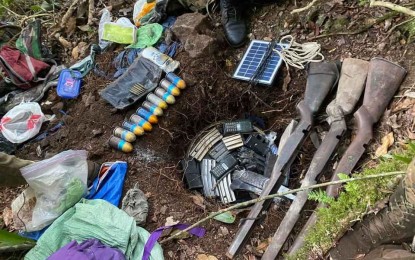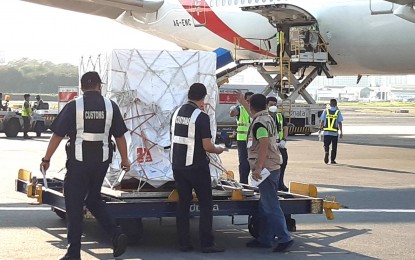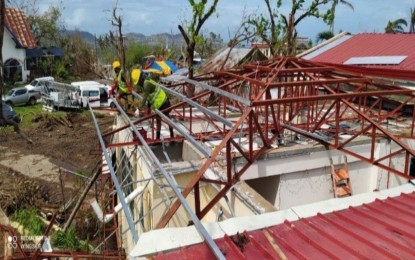When the Taliban took over Afghanistan at the end of August 2021—an event precipitated by the withdrawal of all remaining US troops in the country—questions about the Taliban’s ability to target the Western world and fears that Afghanistan would become a haven for al-Qaeda arose immediately in the minds of many government officials and non-government observers. Such concerns were well-grounded. Since the 11 September 2001, terrorist attacks in the United States, numerous franchises have formed in various parts of the world, and one of them was al-Qaeda in Iraq (AQI), which evolved into today’s the Islamic State in Iraq and Syria (ISIS) terrorist organization. Both al-Qaeda and ISIS have not only competed to be the caliph of Islamic world through the pursuit of utopian ideologies but they also have sought to target the Western world. This article analyzes the capacity of ISIS and al-Qaeda in terms of operational and organizational capabilities, use of violence, geographical expansion, and ideological inspiration for lone actors to determine which group—ISIS or al-Qaeda—is the greater threat to global security.
ISIS and al-Qaeda have engaged in a strategy of global expansion and competition to become the most influential terrorist organization. Wherever political, religious, and economic grievances have prompted Muslim communities to engage in violence and adopt terrorist strategies, both al-Qaeda and ISIS have sought the allegiance of the aggrieved communities.
Table 1 lists a sampling of al-Qaeda-affiliated groups that were in existence between 2015 and 2019, according to the Global Terrorism Database (from the National Consortium for the Study of Terrorism and Responses to Terrorism)[1] and the Statistical Annex Information (from the US Department of State).[2] Most of these groups are still active. Al-Qaeda has used localization policies to create a network of umbrella organizations with groups that pledged allegiance, declared loyalty, or been sympathetic to group’s ideology. Jamaat al-Nusra Wal Muslimin (JNIM) in the Sahel region of Africa and Hay’at Tahrir al-Sham (HTS) in Syria are two examples. HTS was formed with the involvement of Jabhat Fateh al-Sham, the Ansar al-Din Front, Jaysh al-Sunna, Liwa al-Haqq, and the Nour al-Din al-Zenki Movement. Al-Qaeda used the same strategy to create the JNIM group, which resulted from the merger of Ansar Dine, the Macina Liberation Front, al-Mourabitoun, and the Saharan branch in the Islamic Maghreb.

Table 1: A Sampling of al-Qaeda-Affiliated Groups in Existence between 2015 and 2019Al-Shabaab is another active al-Qaeda-affiliated group. It operates in Somalia and Kenya and has been listed by the U.S. Department of State since 2014 as one of the top five terrorist organizations responsible for the most terrorist attacks. In addition to HTS, other al-Qaeda-affiliated groups have filled the vacuums in Syria since 2015 when ISIS began to lose a significant amount of its territory in the country. For example, Hurras al-Dine is based in Idlib (a city in northwestern Syria) but it carried out attacks outside Idlib in 2021.[3] Ongoing conflict in the Jammu and Kashmir region have created opportunities for al-Qaeda to be the address for jihadist groups that have fought against the Indian military.
Other active groups listed in Table 1 that get serious attention from the western world are AQAP, AQIS, and the Haqqani Network. AQAP is still active in the Middle East and operates predominantly in Yemen where it targets pro-government forces and Yemeni military. The Western world has found AQAP to be more menacing than other jihadist groups because of AQAP’s links to radical American cleric Anwar al-Awlaki and its attempts to target the Western world.
Al-Qaeda in the Indian Subcontinent in Afghanistan, Pakistan, Bangladesh, Myanmar, and India.[4] It is the Taliban’s ally and has an extensive network in Afghanistan.[5] The Haqqani Network, which operates in Afghanistan, is a key ally of al-Qaeda and was responsible for an attack that targeted the Inter-Continental Hotel in Kabul in 2011, resulting in the wounding of 77 US soldiers. A 2020 US Department of the Treasury memorandum described how al-Qaeda is gaining strength in Afghanistan and noted that the Haqqani Network had formed a new joint unit of armed fighters in cooperation with Al-Qaeda.[6] A 2021 UN report stated that the Haqqani Network has strong links with regional terrorist groups and is one of the primary liaisons between the Taliban and al-Qaeda.[7]
ISIS, on the other hand, has been one of the world’s most popular terrorist organizations. Founded by Abu Mus’ab al-Zarqawi, the group emerged from al-Qaeda’s remnants in Iraq. After fading into obscurity by 2007, the group reemerged in 2011 and invaded Iraqi territory (Mosul and Tikrit) in 2014 and areas along Syria’s border with Turkey in 2015. A U.S.-led military campaign in 2015 led to considerable losses for ISIS, and the group lost 95 percent of its territory by 2017. The Western world declared victory against ISIS when the group’s leader, Abu Bakr al-Baghdadi, was killed in 2019. ISIS in 2021, however, remained one of the most active terrorist groups in the world based on the number of casualties and the number of terrorist incidents. The organization has around 16,000 militants in Iraq and Syria and has been the perpetrator of around at least 500 terrorist attacks in the region. Even in the refugee camps run and operated by the Syrian Democratic Forces, ISIS has been influential. For example, the women’s wing of ISIS, the al-Hesba Brigade, controls the refugee camps and targets female refugees who oppose the ISIS ideology.
Also contributing to the attractiveness of ISIS is the group’s decision to create and develop a unique operational, ideological, and organizational model.[8] The model had at its foundation the creation of provincial affiliates and the expansion of its twisted and strict interpretation of Islamist ideology. From there it followed that ISIS would seek to control territory, demonstrate a preference for lethal attacks, claim responsibility for attacks it had carried out, and use traditional and social media to generate operating revenue for the group. Implementation of the model enabled ISIS to become one of the most popular and most well-known terrorist organizations in the world. As an extension of the model, ISIS adopted a new strategy of expanding the organization’s reach through the development of loose ties with like-minded individuals and groups that operate as franchises of ISIS.
The franchise approach is successful, leading to ISIS having more franchises than al-Qaeda. Some ISIS franchises, however, were formed during the early years of the terrorist organization’s existence when other jihadist groups in Iraq and Syria competed to be under the banner of ISIS. A significant number of these, and subsequent, franchises have added the ISIS moniker to the franchise group’s name, thereby creating the perception that ISIS is a global organization—even after the organization lost its power in the territories where it operated in Iraq and Syria.
ISIS, however, has been more influential over jihadist groups that operate in Asia and Africa (see Table 2). All jihadist groups in the Philippines, for example, pledged allegiance to ISIS when the organization was at the peak of its popularity. More recently, in 2018, the wing of the Abu Sayyaf in the Basilan province of the Philippines changed its name to ISIS-Philippines. The US Department of State responded by designating the Basilan wing of the Abu Sayyaf as a terrorist organization. ISIS launched its outreach to the Philippines in 2016 for extremists in southern Philippines who could not travel to its self-proclaimed caliphate in Iraq and Syria. In 2017, ISIS was able to overrun the city of Marawi. ISIS-Philippines has been one of the most active and capable ISIS-affiliated groups and was
listed as one of top 10 terrorist groups responsible for the most casualties in 2019.[9]
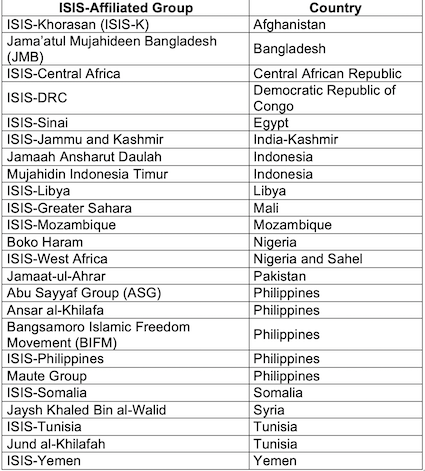 Table 2: A Sampling of ISIS-Affiliated Groups in Existence between 2015 and 2019
Table 2: A Sampling of ISIS-Affiliated Groups in Existence between 2015 and 2019In Africa, ISIS-affiliated groups far outnumber Al-Qaeda-affiliated groups. ISIS has franchises in Nigeria, the Central African Republican, Mozambique, Nigeria, the Sahel, Tunisia, Egypt, Libya, and Somalia, while Al-Qaeda has only two affiliated groups: JNIM in the Sahel and al-Shabaab in Somalia.
Concern about the terrorist groups that operate in the Sahel has been ongoing. U.S.-led military operations, French troops, and United Nations missions all have failed to fend off the activities of these groups. ISIS-Greater Sahara (ISIS-GS) and ISIS-West Africa are two ISIS franchises that are active in the Sahel. ISIS-West Africa, operating in Nigeria, gained popularity after it killed the leader of Boko Haram, Abubakar Shekau, in 2021. The group was formed in 2016 by Boko Haram defectors and expanded its operational capacity to Chad, Niger, and Cameroon. In 2018, ISIS-West Africa was the perpetrator of 22 attacks in which a total of 160 individuals were killed.[10] The group relies on a hearts-and-minds approach in its operational regions, selectively targeting Christians, state institutions, and military personnel. ISIS-GS operates mostly in Mali. The group came to prominence in 2015 when al-Mourabitoun, a group affiliated with al-Qaeda, pledged allegiance to ISIS. In 2017, ISIS-GS targeted and killed four US soldiers.[11]
ISIS provincial franchises in Libya, Tunisia, and Egypt perpetrated 347 terrorist incidents in 2019, up slightly from 345 incidents in 2018. ISIS-Libya emerged in Derna, a port city in eastern Libya, in 2014 when a group of 300 former Libyan members of the Battar Brigade returned to their country after fighting in Syria and allied with the Ansar al-Sharia terrorist group. ISIS-Tunisia emerged in 2015 when the group was involved in attacks in Sousse, Tunisia, including the targeting of the Bardo Museum.[12] ISIS-Tunisia has maintained its capacity to carry out attacks in the country, where the group executed two suicide attacks in 2019.[13]
In Egypt, which also hosts many jihadist terrorist groups, most of the attacks by these groups have occurred in the northern Sinai area. ISIS-Sinai was to blame for 320 terrorist attacks between 2013 and 2017. This ISIS franchise originated from the Sunni Salafist Ansar Bayt al-Maqdis terrorist group that declared war against the Egyptian government immediately after the ouster of President Mohamed Morsi in a July 2013 military coup. The origin of the ISIS-Somalia franchise dates to 2012 when al-Shabaab assigned Abdul Qadir Mumin to operate in its remote outpost in Puntland in northeastern Somalia.[15]
ISIS-Democratic Republic of Congo (ISIS-DRC) emerged in 2017 in the Democratic Republic of Congo when militants from a new brand of the rebel group Allied Democratic Forces (ADF). Known as the City of Monotheism and Monotheists, the group leaned toward ISIS. The ADF is an Islamist group that has fought against the governments of the DRC and Uganda for several years. The US Department of State designated ISIS-DRC as a foreign terrorist organization in 2021 along with the ISIS branch in Mozambique (ISIS-Mozambique). In October and November 2021, ISIS-DRC was able to expand its capacity to Uganda and was the perpetrator of several attacks.
Mozambique’s experience with violence by Islamic extremists began when Al Sunna wa Jama’ah popped up in the eastern part of the country in 2017. Referred to by locals as al-Shabaab, the group’s grievances included dissatisfaction with widespread poverty and inequality, frustration over the government’s ineffective policies for addressing those issues, and the expansion of Salafist ideology with support from the Gulf States in the form of funding for mosques, social programs, and young students who wanted to study abroad and propagate Wahhabi Islam. The rising influence of Wahhabism led to conflict with Sufi Muslims in the country, resulting in the death of 300 people and the displacement of thousands of others.[16] By 2019, the terrorist group al-Sunna wa Jama’ah emerged and was acknowledged by ISIS as one of its affiliates. Like other ISIS provincial franchises, al-Sunna selectively targeted military troops.
Operational Capabilities and Use of ViolenceOperational capabilities have been critical in the analysis of terrorist organizations in terms of which group should be considered the most dangerous. Both the al-Qaeda and ISIS core groups and their franchises have the capacity to use terrorist tactics ranging from improvised explosive devices (IEDs), vehicle borne improvised explosive devices, suicide bombings, drone attacks, and mortar launchings. According to the 2019 Annex of Statistical Information, ISIS-Core used explosives in 10 percent of the group’s attacks and IEDS in 37 percent of its attacks.[17] Al-Shabaab, as a strong franchise of al-Qaeda in Africa, used explosives in 11 percent of the group’s attacks and IEDs in 33 percent of its attacks. When it comes to assassinations, ISIS-Core used the tactic slightly more often than did Al Shabaab (19 percent and 15 percent, respectively). ISIS-Core also outdid Al Shabaab in the use of suicide bombings (18 percent and 16 percent, respectively).[18]
Other tactics that indicate the operational capacity of terrorist organizations are the use of complex coordinated terrorist attacks (CCTAs), multiple terrorist tactics in a single attack, and campaign attacks.[19] Al-Qaeda’s attacks in Europe, such as the 2004 Madrid bombings[20] and the 2007 London bombings,[21] were replaced by ISIS CCTAs in Europe in the mid-2010s, such as the Paris attacks in 2015[22] and the Brussels bombings in 2016.[23] An ISIS franchise in Sri Lanka, the National Tawheed Jamaah, was the perpetrator of the 2018 Easter Day attacks that killed more than 300 people in seven separate targets.[24] In 2021, ISIS-K deployed a suicide bomber who stormed Afghanistan International Airport, killing 170 civilians and 13 US service members. The deadly incident is another example of how ISIS franchises are capable of using multiple tactics in a single attack. Today, ISIS seems to be more capable of using CCTAs in Europe than al-Qaeda does; however, it should be noted that al-Qaeda-affiliated groups in the Sahel, Somalia, and Syria are indeed capable of conducting CCTAs. In this context, the use of campaign attacks indicates the extent to which terrorist organizations are capable of executing global attacks. In 2018, for example, ISIS-Core conducted campaign attacks in more than 10 countries after the organization lost one of its strongholds in Syria.[25]
Group leadership is another indicator of operational capacity. ISIS excels in this area compared with al-Qaeda. ISIS has a strong and influential leadership model that enables the organization to exert some measure of control over its franchises. In contrast, al-Qaeda leader Ayman al Zawahiri is over 80 years old and has less control over the al-Qaeda-core group and the core group’s franchises. The ISIS model also enabled the organization to quickly replace its leader, Abu Bakr al-Baghdadi, after he was killed in a targeted US military operation in 2019. The speed at which the ISIS leader was replaced sent a message to counterterrorism experts about the effectiveness of the decapitation component of the Western counterterrorism model.
Terrorist groups rarely are random or senseless in the selection of their targets. They use violence strategically to send messages to an outside audience, such as the Western world. ISIS groups appear to be more violent than al-Qaeda groups. In 2019, the Annex of Statistical Information report
listed four ISIS groups responsible for the most casualties (i.e., persons killed and wounded): ISIS-Core, ISIS-West Africa, ISIS-K, and ISIS-Philippines.[26] This list included only two al-Qaeda groups: HTS and al-Shabaab. According to the casualty rate (obtained by dividing the number of casualties by the number of incidents attributed to a particular group) given in the 2019 report, of the top five ISIS and al-Qaeda groups responsible for the most incidents, ISIS-affiliated groups were the more violent of the two groups (see Figure 1). For example, ISIS-K killed or wounded 724 people in 47 incidents, followed by ISIS-West Africa, which killed or wounded 1,222 people in 85 incidents. The most violent al-Qaeda group was HTS, with a casualty rate of 7.7.[27]
 Figure 1: Casualty rates for ISIS-affiliated (blue) and al-Qaeda-affiliated (red) groups in 2019
Figure 1: Casualty rates for ISIS-affiliated (blue) and al-Qaeda-affiliated (red) groups in 2019Figure 1 compares the attacks and casualties for which ISIS-affiliated groups and al-Qaeda-affiliated groups were responsible in 2019. ISIS-affiliated groups killed or wounded 6,652 people in 959 incidents, while al-Qaeda-affiliated groups killed or wounded 4,420 people in 767 incidents.[28]
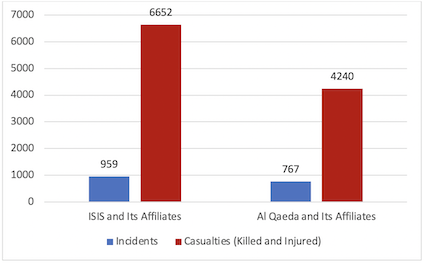 Figure 2: Comparison of the number of attacks and casualties for which ISIS-affiliated groups and al-Qaeda-affiliated groups were responsible in 2019
Figure 2: Comparison of the number of attacks and casualties for which ISIS-affiliated groups and al-Qaeda-affiliated groups were responsible in 2019In terms of using violent tactics, ISIS-affiliated groups have been more violent than al-Qaeda-affiliated groups. For example, ISIS-affiliated groups were involved in more beheading incidents than al-Qaeda-affiliated groups between 2014 and 2020, according to another dataset, which was collected by the author. For example, as shown in Figure 3, ISIS-Core was the perpetrator of 717 out of 1,256 beheadings in Iraq and Syria. Copying the core organization’s tactics, other ISIS-affiliated groups also used beheading as one of their tactics. Additionally, ISIS-Core was involved in incidents where people were burned alive.[29]
 Figure 3: Number of beheaded victims, by perpetrator group. Note that all of the groups listed here—except for Lone Actor (Jihadist), Taliban, and Al Shabaab—are ISIS and its affiliates.Lone Actor Attacks
Figure 3: Number of beheaded victims, by perpetrator group. Note that all of the groups listed here—except for Lone Actor (Jihadist), Taliban, and Al Shabaab—are ISIS and its affiliates.Lone Actor AttacksLone actor terrorism poses an enormous threat that shows no signs of abating. Starting from the early 2010s, the world has witnessed an increase in the number of lone actor attacks. Such attacks are committed by individuals who operate according to their own timetable and do not have any formal connections with any terrorist organizations. These individuals are mostly self-radicalized and inspired by a terrorist ideology. Two ideologies—right-wing extremism and jihadism—are dominant among lone actors. When jihadist groups realized that victory over the well-equipped and well-developed Western military was impossible, they changed their tactics and encouraged their sympathizers to operate like sleeper cells in their home countries in the Western world. According the dataset Profiles of Individual Radicalization in the United States, the ISIS ideology inspired more people to self-radicalize than did the al-Qaeda ideology.[30] According to author’s dataset of information on lone actors between 2014 and 2020, ISIS-inspired individuals outnumbered al-Qaeda-inspired individuals (95 percent and 5 percent, respectively).[31]
ConclusionISIS has been the predominant terrorist organization in the Middle East since the launch of Syrian civil war, dwarfing considerably the stature of al-Qaeda which, at one point, was seen as a significant threat in the region and elsewhere. The world media has reported, for example, that ISIS has gained territory in Syria and Iraq, is the ruler of at least 6 million people in Iraq and Syria, has been the perpetrator of violent attacks, and has expanded its franchises in Africa, the Middle East, and Asia. Therefore, ISIS is perceived as being a more serious threat than al-Qaeda.
It would not be wrong to say that ISIS has been more successful than al-Qaeda at spreading its global influence, using indiscriminate violence, inspiring lone actors, and attracting media attention and coverage. Al-Qaeda, however, should not be underestimated. Al-Qaeda has renewed its capacity to act as a terrorist organization, its presence has increased in many regions, and it has shown that it is capable of competing on the same level as ISIS. Al-Qaeda franchises in Syria, Somalia, and the Sahel have gained popularity among potential radicals and are capable of targeting local military, international military, and state institutions. Unlike ISIS-Core and its franchises that indiscriminately target civilians, al-Qaeda-affiliated groups are more strategic in the selection and use of their terrorism targets.
On the flip side, the brutality and beheadings for which ISIS has come to be known and its penchant for claiming responsibility for almost every incident that happens in the Western world have resulted in a loss of credibility for the terrorist organization. It should be noted that until 2016, ISIS had been one of the most reliable terrorist organizations in terms of claiming responsibility for attacks that it truly had perpetrated. In the years since then, ISIS jumps at every chance to claim responsibility for terrorist attack and, at times, will make false claims of perpetrating an attack—just to maintain or bolster its popularity. The tide, however, has turned. Now al-Qaeda has the distinction of being more reliable than ISIS. Terrorism databases, for example, show that around 500 ISIS-Core attacks occur each year, a number far lower than the number of terrorist attacks for which ISIS has claimed responsibility. Al-Qaeda and its affiliates (e.g., al-Shabaab, JNIM, and HTS) on the other hand have claimed responsibility only when they were real attackers.
As one might expect, the rivalry between ISIS and al-Qaeda continues. It is common, for example, to see clashes between ISIS affiliates and al-Qaeda affiliates and for the al-Qaeda affiliates to dominate ISIS in most regions. For example, Al Shabaab has been known to clash with ISIS-Somalia, JNIM with ISIS-GS, the Taliban with ISIS-K, and AQAP with ISIS-Yemen. In most cases, Al-Qaeda affiliates have gained victories against ISIS affiliates.
The Taliban’s takeover of Afghanistan in August 2021, however, has complicated the ISIS-al-Qaeda conflict. With help from the Haqqani Network, the Taliban and al-Qaeda have developed strong ties to each other. Al-Qaeda’s leader, for example, praised and congratulated the Taliban for its successful takeover of Afghanistan. In another example, just as the Taliban provided safe haven to al-Qaeda before 9/11, it is believed that Al-Qaeda will enjoy immunity in Afghanistan under the Taliban government. To conclude, it would not be wrong to expect ongoing lone actor attacks by ISIS-inspired individuals in the Western world nor an increase in al-Qaeda’s capacity and influence in Asia, the Middle East, and Africa. Both ISIS and al-Qaeda deserve close attention, but the world needs to be aware of al-Qaeda’s increasing capacity as a global terror threat.
Endnotes[1] Global Terrorism Database. The National Consortium for the Study of Terrorism and Responses to Terrorism (START),
https://www.start.umd.edu/gtd/.
[2] Development Services Group, “Annex of Statistical Information 2019: Country Report on Terrorism 2019.” Global Terrorism Trends and Analysis Center, US Department of State. 10 June 2020,
https://www.state.gov/wp-content/uploads/2020/06/Annex-of-Statistical-Information.pdf.
[3] Khaled al-Khateb, “Table 1: A Sampling of Al Qaeda-Affiliated Groups
in Existence between 2015 and 2019.” Al-Monitor. 11 January 2021,
https://www.al-monitor.com/originals/2021/01/syria-hurras-al-din-idlib-raqqa-attack-islamic-state.html.
[4] “Al-Qaeda in the Indian Subcontinent (AQIS).” Mapping Militant Organizations. Stanford: Stanford University, Center for International Security and Cooperation (CISAC). July 2018,
https://cisac.fsi.stanford.edu/mappingmilitants/profiles/al-qaeda-indian-subcontinent-aqis.
[5] Iftekharul Bashar, “Rise of the Taliban in Afghanistan: Security Implications for Bangladesh.” Counter Terrorist Trends and Analyses. Vol. 13, no. 4. International Centre for Political Violence and Terrorism Research, 2021: pp. 19–24,
https://www.jstor.org/stable/48618779.
[6] Gregory Sullivan, Audit Director to Lead Inspector General, Department of Defense, Memorandum, “Operation Inherent Resolve - Summary of Work Performed by the Department of the Treasury Related to Terrorist Financing, ISIS, and Anti-Money Laundering for First Quarter Fiscal Year 2021.”US Department of the Treasury. 4 January 2021,
https://oig.treasury.gov/sites/oig/files/2021-01/OIG-CA-21-012.pdf.
[7] “Twelfth report of the Analytical Support and Sanctions Monitoring Team submitted pursuant to resolution
2557 (2020) concerning the Taliban and other associated individuals and entities constituting a threat to the peace stability and security of Afghanistan.” Analytical Support and Sanctions Monitoring Team to the United Nations Security Council, S/2021/486. 1 June 2021,
https://www.undocs.org/pdf?symbol=en/S/2021/486.
[8] Mahmut Cengiz, “The ISIS Model and its Influence Over Global Terrorism.” Paper presented to International Criminology Conference 2021. Washington, DC (Virtual): Policy Studies Organization. 5 Novemebr 2021,
https://www.youtube.com/watch?v=6vue0u0_IPY.
[9] Op.Cit. “Annex of Statistical Information 2019: Country Report on Terrorism 2019” at Note 2.
[10] Ibid.
[11] Ned Price, “On the Death of ISIS-GS Leader Adnan Abu Walid Al-Sahrawi.” Press Release. US Department of State. 17 September 2021,
https://www.state.gov/on-the-death-of-isis-gs-leader-adnan-abu-walid-al-sahrawi/.
[12] Will Hartley, “
Vehicle-impact and knife attack underlines persistent low-level Islamic State threat in Tunisia.” Janes. 24 September 2020,
https://www.janes.com/defence-news/news-detail/vehicle-impact-and-knife-attack-underlines-persistent-low-level-islamic-state-threat-in-tunisia,
[13] “Tunisia: Extremism and Terrorism.” Counter Extremism Project. No Date [Accessed 9 January 2022],
https://www.counterextremism.com/countries/tunisia.
[14] “Terrorism in Egypt.” WorldData.info. No Date [Accessed 9 January 2022],
https://www.worlddata.info/africa/egypt/terrorism.php.
[15] Jason Warner, “Sub-Saharan Africa’s Three “New” Islamic State Affiliates.” CTC Sentinel. Vol. 10, no. 1. January 2017,
https://ctc.usma.edu/sub-saharan-africas-three-new-islamic-state-affiliates/.
[16] Marc Chua, “Challenges Within Mozambique.” Small Wars Journal. 15 January 2020,
https://smallwarsjournal.com/jrnl/art/challenges-within-mozambique.
[17] Op.Cit. “Annex of Statistical Information 2019: Country Report on Terrorism 2019” at Note 2.
[18] Ibid.
[19] On complex coordinated terrorist attacks (CCTAs), see John P. Sullivan and Adam Elkus, “Postcard from Mumbai: Modern Urban Siege.” Small Wars Journal. 16 February 2009,
https://smallwarsjouranl.com/jrnl/art/postcard-mumbai-modern-urban-siege.
[20] Fernado Reinares,
Al-Qaeda’s Revenge: The 2004 Madrid Train Bombings. New York: Columbia University Press, 2017.
[21] Kevin J. Strom and Joe Eyerman, “Interagency Coordination: Lessons Learned From the 2005 London Train Bombings.” NIJ Journal. Issue No. 261. October 2008,
https://www.ojp.gov/pdffiles1/nij/224088.pdf.
[22] Two sequences of attacks against targets in Paris occurred in 2015. The first 7-9 January 2015 targeted the offices of the journal Charie Hebdo and was followed by a hostage situation and shootings, as well as an attack on the Hypercacher Kosher market. , “John P. Sullivan and Adam Elkus, “Urban Siege in Paris: A Spectrum of Armed Assault.” Small Wars Journal. 2 February 2015,
https://smallwarsjournal.com/jrnl/art/urban-siege-in-paris-a-spectrum-of-armed-assault. The second on [13] November 2015 involved the siege of the Bataclan. Jean-Charles Brisard, “The Paris Attacks and the Evolving Islamic State Threat to France. CTC Sentinel. Vol. 8, no. 11. November/December 2015,
https://ctc.usma.edu/the-paris-attacks-and-the-evolving-islamic-state-threat-to-france/.
[23] See Jean-Charles Brisard and Kevin Jackson, “The Islamic State’s External Operations and the French-Belgian Nexus.” CTC Sentinel. Vol. 9, no. 11. November/December 2016,
https://ctc.usma.edu/the-islamic-states-external-operations-and-the-french-belgian-nexus/.
[24] Amarnath Amarasingam, “Terrorism on the Teardrop Island: Understanding the Easter 2019 Attacks in Sri Lanka.” CTC Sentinel. Vol. 12, no. 5. May/June 2019,
https://ctc.usma.edu/terrorism-teardrop-island-understanding-easter-2019-attacks-sri-lanka/.
[25] Op.Cit. “Annex of Statistical Information 2019: Country Report on Terrorism 2019” at Note 2.
[26] Ibid.
[27] Ibid.
[28] Ibid.
[29] Ibid.
[30] “Profiles of Individual Radicalization in the United States - PIRUS (Keshif).” The National Consortium for the Study of Terrorism and Responses to Terrorism (START). Accessed 9 January 2022,
https://www.start.umd/edu/profiles-individual-radicalization-united-states-prius-keshif.
[31] Author’s dataset with Dr. Kutluer Karademir. The dataset recorded 251 attacks between 2014 and 2020 by individuals that qualify the definition of lone actors.
Categories:
terrorismLog in or
register to post comments
About the Author(s)
Mahmut Cengiz[Dr. Mahmut Cengiz is an Assistant Professor and Research Faculty with Terrorism, Transnational Crime and Corruption Center (TraCCC) and the Schar School of Policy and Government at George Mason University. Dr. Cengiz has international field experience where he has delivered capacity building and training assistance to international partners in the Middle East, Asia, and Europe. He also has been involved in the research projects for the Brookings Institute, European Union, and various US agencies.] https://smallwarsjournal.com/jrnl/art/isis-or-al-qaeda-which-looms-greater-threat-global-security

















